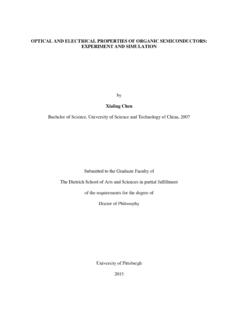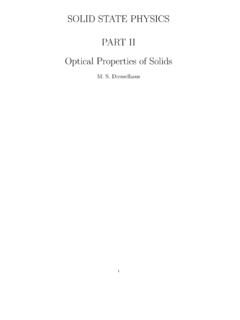Transcription of SOLID STATE PHYSICS PART II Optical Properties of Solids
1 SOLIDSTATEPHYSICSPART IIOpticalPropertiesofSolidsM. S. Dresselhaus1 Contents1 Reviewof Fundamental Relationsfor OpticalProbes .. the complexopticalconductivity .. ComplexDielectricFunctionto Observables.. FrequencyMeasurements ..72 DrudeTheory{Free CarrierContributionto the CarrierContribution.. FrequencyResponse:! 1 .. ;! 1 .. 113 .. the Hamiltonianin an ElectromagneticField.. MomentumMatrixElements and the E ective Mass.. Solids .. 234 TheJoint Density of Statesand Density of States.. 305 Absorptionof Light in cient .. CarrierAbsorptionin semiconductors .. CarrierAbsorptionin Metals.. AbsorptionEdgeon FermiEnergy.. AbsorptionEdgeon AppliedElectricField.. CrystalMomentumin DirectOpticalTransitions.. 5026 OpticalPropertiesof SolidsOver a {KronigRelations.. BandStructure.. ectivity Experiments .. Measurement of OpticalConstants .. 717 Impuritiesand Level Spectroscopy .. Impurity Levels .. HydrogenicModel.}}
2 ,ColorCenters and Interstitials.. of Excitons.. cationof Excitons.. QuantumWell Structures.. 918 Luminescenceand cationof LuminescenceProcesses.. Absorption.. 10410 OpticalStudyof semiconductors .. and Polarizability .. Scattering.. Light Scattering.. QuantumWells and Superlattices.. 12811 .. 13612 ElectronSpectroscopy and .. PhotoelectronSpectroscopy .. raction.. , EELS.. (AES).. 15613 .. AmorphousSemiconductors.. Properties .. AmorphousSemiconductors.. 176A TimeDependent .. 2nd OrderPerturbationTheory.. 184B HarmonicOscillators,Phonons,and the .. 3D Crystals.. 1924 Chapter1 Reviewof Fundamental Relationsfor OpticalPhenomenaReferences: G. Beke and ,ElectromagneticVibrationsWavesand Radiation, MITP ress,Cambridge,MA ,Classical Electrodynamics, Wiley, NewYork,1975 Bassaniand Pastori{Parravicini,ElectronicStatesand Optical Transitionsin Solids ,PergamonPress,NY (1975). Yu and Cardona,Fundamentals of semiconductors ,SpringerVerlag(1996) OpticalProbesTheopticalpropertiesof solidsprovidean important tool for studyingenergybandstruc-ture,impurity levels, excitons,localizeddefects,latticevibrati ons, such experiments, we measuresomeobservable,such as re ectivity, trans-mission,absorption,ellipsometryor light scattering;fromthesemeasurements we deducethe dielectricfunction"(!)}
3 , the opticalconductivity (!), or the fundamental is the frequency-dependent complexdielectricfunction"(!) or the complexconductivity (!), which is directlyrelatedto the energybandstructureof the relationshipbetween experimental observationsandtheelectronicenergylevels (energybands)of the the infraredphotonenergyregion,informationon the phononbranches is the major concernofPart II of this Complexdielectricfunctionand the complexopticalconductivityThecomplexdiel ectricfunctionand complexopticalconductivity are introducedthroughMaxwell'sequations( )r ~H 1c@~D@t=4 c~j( )r ~E+1c@~B@t= 0( )r ~D= 0( )r ~B= 0( )wherewe have assumedthatthe chargedensity is equationsare writtenas:~D="~E( )~B= ~H( )~j= ~E( ) de nesthe quantity"fromwhich the conceptof the complexdielectricfunc-tionwill be developed. Whenwe discussnon{linearoptics(seeChapter11),th eselinearconstitutive equations( { )must be generalizedto includehigherordertermsin~E~Eand~E~E~E. FromMaxwell's equationsand the constitutive equations,we obtaina waveequationfor the eldvariables~Eand~H:r2~E=" c2@2~E@t2+4 c2@ c2@2~H@t2+4 c2@ Optical elds,we must look for a sinusoidalsolutionto and ~E=~E0ei(~K ~r !)}}
4 T)( )where~Kis a complexpropagationconstant and!is the frequencyof the light. A solutionsimilarto Eq. obtainedfor the~H ~Kcan be identi edas awave vector,whilethe imaginarypartof~Kaccounts for attenuationof the wave the planewave solutionEq. the wave equationEq. yieldsthe followingrelationforK: K2= " !2c2 4 i !c2:( )If therewere no losses(or attenuation),Kwouldbe equaltoK0=!cp" ( )2and wouldbe real,but sincethereare losseswe writeK=!cp"complex ( )wherewe have de nedthe complexdielectricfunctionas"complex="+4 i !="1+i"2:( )As shown in Eq. is customaryto write"1and"2for the real and imaginarypartsof"complex. Fromthe de nitionin Eq. alsofollows that"complex=4 i! +"!4 i =4 i! complex;( )wherewe de nethe complexconductivity complexas: complex= +"!4 i( )Now thatwe have de nedthe complexdielectricfunction"complexandthe complexconductivity complex, we will relatethesequantitiesin two ways:1. to observablessuch as the re ectivity which we measurein the laboratory,2. to propertiesof the solidsuch as the carrierdensity, relaxationtime,e ective masses,energybandgaps, Eq.
5 ,the solutionEq. the wave equation( )yieldsa planewave~E(z;t) =~E0e i!texp0@i!zcp" s1 +4 i "!1A:( )For the wave propagatingin vacuum("= 1, = 1, = 0), Eq. a simpleplanewave solution,whileif the wave is propagatingin a mediumof niteelectricalconductivity,the amplitudeof the wave exponentiallydecays over a characteristicdistance given by =c!~N2(!)=c!~k(!)( )where is calledthe opticalskindepth,and~kis the imaginarypartof the complexindexof refraction(alsocalledthe extinctioncoe cient)~N(!) =p "complex=s" 1 +4 i "! = ~n(!) +i~k(!):( )Thismeansthattheintensityof the electric eld,jEj2, fallso to 1=eof its valueat thesurfacein a distance1 abs=c2!~k(!)( )3where abs(!) is the absorptioncoe cient for the solidat frequency!.Sincelight is described by a transversewave, thereare two possibleorthogonaldirec-tionsfor the~Evectorin a planenormalto the propagationdirectionand thesedirectionsdeterminethepolarizationo f the light. For cubicmaterials,the indexof refractionis thesamealongthe two , for anisotropicmedia,the indicesofrefractionmay be di erent for the two polarizationdirections,as is ComplexDielectricFunctionto ObservablesIn relating"complexand complexto the observables,it is convenient to introducea complexindexof refraction~Ncomplex~Ncomplex=p "complex( )whereK=!
6 C~Ncomplex( )and where~Ncomplexis usuallywrittenin termsof its real and imaginaryparts(see Eq. )~Ncomplex= ~n+i~k=~N1+i~N2:( )Thequantities~nand~kare collectively calledthe opticalconstantsof the SOLID ,where~nis the indexof refractionand~kis the extinctioncoe cient. (We use the tildeover theopticalconstants ~nand~kto distinguishthemfromthe carrierdensity and wave vectorwhichare denotedbynandk). Theextinctioncoe cient~kvanishesfor ,we can take = 1, and this will be donein writingthe de nitionfor~Ncomplex, we can relate"complex="1+i"2= (~n+i~k)2( )yieldingthe important relations"1= ~n2 ~k2( )"2= 2~n~k( )wherewe notethat"1;"2;~nand~kare all measurements of the opticalpropertiesof solidsinvolve the normalincidencere ectivity which is illustratedin SOLID ,the wave will be assumefor the present discussionthatthe solidis thick enoughso thatre ectionsfromthe back surfacecan be can thenwritethe wave insidethe solidfor thisone-dimensionalpropagationproblemasE x=E0ei(Kz !t)( )wherethe complexpropagationconstant for the light is given byK= (!)
7 =c)~ the otherhand,in free spacewe have both an incident and a re ectedwave:Ex=E1ei(!zc !t)+E2ei( !zc !t):( ) :Schematicdiagramfor normalincidencere ,the continuity ofExacrossthe surfaceof the solidrequiresthatE0=E1+E2:( )With~Ein thexdirection,the secondrelationbetweenE0;E1;andE2follows fromthecontinuity conditionfor tangentialHyacrossthe boundaryof the 'sequation( )we haver ~E= c@~H@t=i !c~H( )which resultsin@Ex@z=i !cHy:( )Thecontinuity conditiononHythus yieldsa continuity relationfor@Ex=@zso thatfromEq. !c E2!c=E0!c~Ncomplex( )orE1 E2=E0~Ncomplex:( )Thenormalincidencere ectivityRis thenwrittenasR= E2E1 2( )which is mostconveniently relatedto the re ectioncoe cientrgiven byr=E2E1:( ) ,we have the resultsE2=12E0(1 ~Ncomplex)( )E1=12E0(1 +~Ncomplex)( )so thatthe normalincidencere ectivity becomesR= 1 ~Ncomplex1 +~Ncomplex 2=(1 ~n)2+~k2(1 + ~n)2+~k2( )wherethe re ectivityRis a number less thanunity. We have now relatedone of thephysicalobservablesto the opticalconstants.
8 To relatetheseresultsto the power absorbedand transmittedat normalincidence,we utilizethe followingrelationwhich expressestheideathatall the incident power is eitherre ected,absorbed, or transmitted1 =R+A+T( )whereR,A, andTare, respectively, the fractionof the power thatis re ected,absorbed, andtransmittedas illustratedin hightemperatures,the mostcommonobservableis the emissivity, which is equalto the absorbed power for a black body or is equalto 1 RassumingT= a homework exercise,it is instructive to derive expressionsforRandTwhenwe have relaxedthe restrictionof no re ectionfromthe back ectionsare encounteredin thin discussionthus far has been directedtoward relatingthe complexdielectricfunctionor the complexconductivity to we know the opticalconstants, thenwe can ndthe re ectivity. We now want to ask the we knowthe re ectivity, can we ndthe opticalconstants? Sincethereare two opticalconstants,~nand~k, we needto make two independent measurements, such as the re ectivity at twodi erent anglesof ,even if we limitourselves to normalincidencere ectivity measurements,we can stillobtainboth ~nand~kprovidedthatwe make thesere ectivity measurementsfor all possiblebecausethe realandimaginarypartsof a complexphysicalfunctionare not independent.
9 Becauseof causality, ~n(!) and~k(!) are relatedthroughthe Kramers{Kronigrelation,which we will discussin Chapter6. Sincenormalincidencemeasurements are easierto carryout in practice,it is quitepossibleto studythe opticalpropertiesof solidswithjustnormalincidencemeasurement s, andthendo aKramers{Kroniganalysisof the re ectivity datato obtainthe frequency{dependent di-electricfunctions"1(!) and"2(!) or the frequency{dependent opticalconstants ~n(!) and~k(!).In treatinga SOLID ,we will needto considercontributionsto the beginwith,thereareintrabandprocesseswhic h correspond to the electronicconductionby free carriers,and henceare moreimportantin conductingmaterialssuch as metals,semimetalsand be understood in theirsimplesttermsby the classicalDrudetheory,or in moredetailby the classicalBoltzmannequationor the additionto the intraband(freecarrier)processes,thereare interband6processeswhich correspond to the absorptionof electromagneticradiationby an electronin an occupiedstatebelow the Fermilevel, thereby inducinga transitionto an unoccupiedstatein a is intrinsicallya quantummechanicalprocessand must be discussedin termsof practice,we considerin detailthe contributionof onlya few energybandsto opticalproperties.}}}}
10 In many caseswe alsorestrictourselves to detailedconsiderationof onlya portionof the interbandcontributionsthatare neglectedare treatedin an approximateway by introducinga coredielectricconstantwhich is oftentaken to be independent of frequencyand FrequencyMeasurementsThefrequencyof light is measuredin several di erent unitsin the the variousunitsare:1 eV = 1= 2:418 1014Hz = 11,600K. Also1 eV correspondsto a wavelengthof m, and 1 cm 1= 3 {Free CarrierContributionto the CarrierContributionIn this chapterwe relatethe opticalconstants to the electronicpropertiesof the contributionto the dielectricfunctionis throughthe \freecarriers".Such free carriercontributionsare very important in semiconductorsand metals,and can be understood intermsof a simpleclassicalconductivity model, calledthe Drudemodel. Thismodel is basedon the classicalequationsof motionof an electronin an opticalelectric eld,and gives thesimplesttheoryof the opticalconstants. Theclassicalequationfor the driftvelocity of thecarrier~vis given bymd~vdt+m~v =e~E0e i!}



















